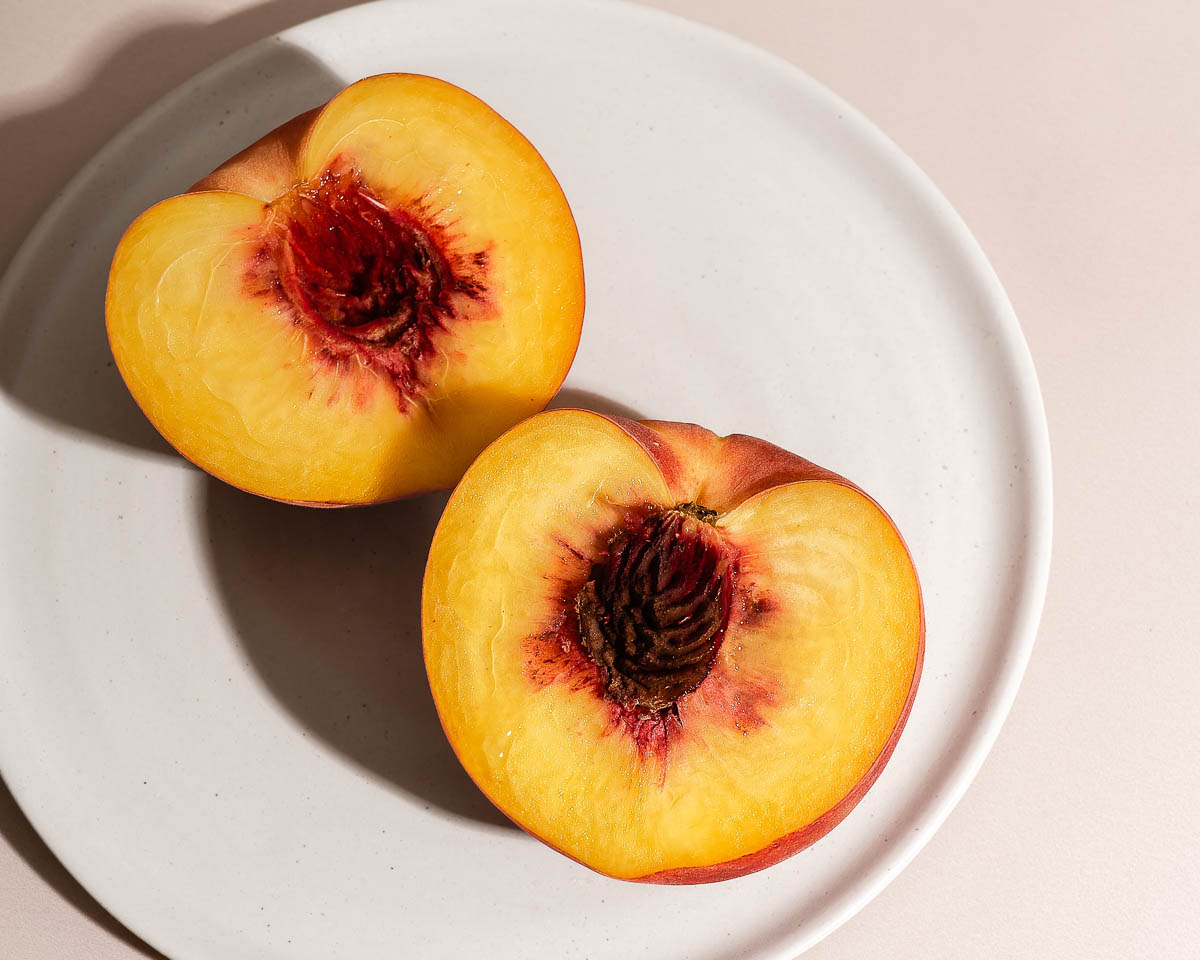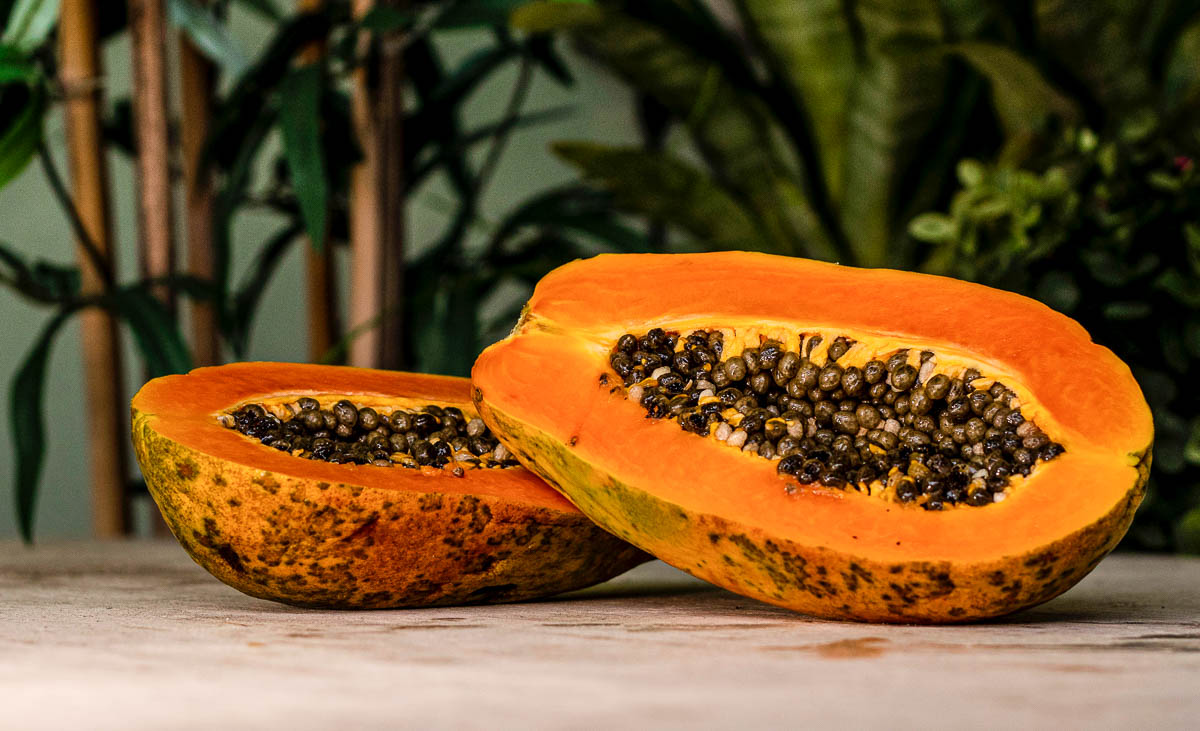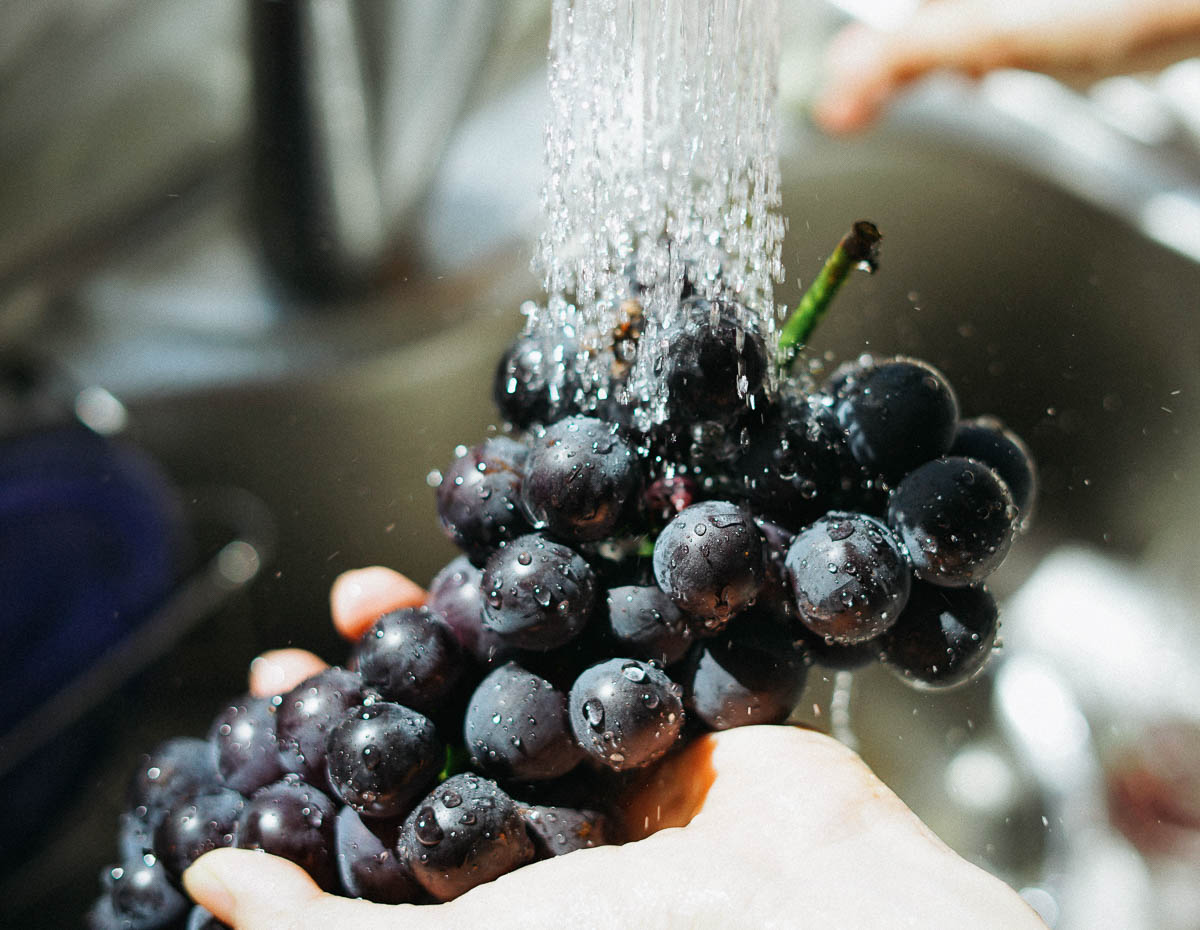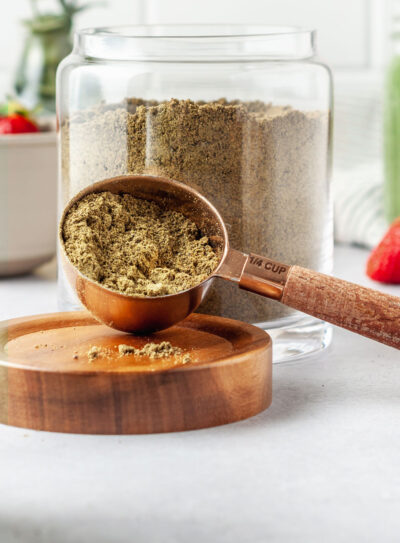This post may contain affiliate links, meaning I can earn a small commission from items you purchase (at no cost to you).
Table of Contents
I use the EWG guide (Environmental Working Group) for their annual Dirty Dozen List as well as their Clean 15 List to determine what organic produce I buy. My budget doesn’t allow me to purchase 100% organic and that’s okay! This list is a great way to help me make the best decisions for my family, and I hope it can help you, too.

When I started Simple Green Smoothies, it was out of inspiration and desperation. My young family had moved across the country, quit our jobs and sold our beloved house to start a new life and live out a dream. It was scary and a huge financial burden. We went without health insurance for a while, scraping together what we could anytime someone got sick or needed to see a medical professional.
I knew I had to help my family as much as I could through food decisions as we navigated cold & flu season without stability. We started using our WIC allowance each month to buy ingredients for green smoothies and I immediately saw the difference in our overall health. We weren’t getting sick as often and when we did, it wasn’t for as long or as serious.
Now that we have much more stability (yay for jobs and health insurance!), I can splurge on some organic produce to help my family further. Hear me say loud and clear all produce is good. All of it, organic or not, bought at a grocery store, through a CSA, at a roadside stand or picked from a garden. My goal is to help us all consume more of it, every day, a wide variety and have fun with it.
2024 Dirty Dozen Produce List
The EWG has a variety of guides to help you make decisions on everything from sunscreen to water and food. They do the research and then publish their results in easy-to-read guides.
Note: I still feel comfortable buying non-organic varieties of the food listed below, so no need to stress about this! Here is the produce they determined to have the most pesticide residue and recommend buying organic versions when you can:
Strawberries

These make the Dirty Dozen List every year, and it makes sense! Strawberries don’t have a protective peel on them. I don’t know about you but my family eats strawberries like they are going out of style, so I choose to buy organic every time.
We love eating strawberries plain, yet they make incredible smoothie additions as well! Blending a strawberry smoothie, a strawberry banana smoothie or a strawberry spinach smoothie is a great way to enjoy these ruby-red delights. Plus, they make a great chia jam!
Spinach, Kale, Collard & Mustard Greens

It’s actually pretty easy for me to say yes to buying the organic version of spinach since Costco sells it in a giant bag for less than $6. I toss it into smoothies and salads like my crunchy chickpea salad, as well as freeze spinach in silicone bags to avoid it getting slimy in the fridge.
To avoid excess pesticide residues in your leafy greens, opt for organic varieties. I have a fairly easy time finding seasonal greens at the local farmers market, and just grab whatever is in season.
Pro Tip: If you are buying locally, you can ask the farmer directly about their farming practices. I find that many farmers follow strict practices that limit pesticide exposure, yet aren’t USDA certified organic because it is a very expensive and extensive process to follow. I feel comfortable purchasing from these vendors after talking to them and understanding how they farm.
Grapes

Does anyone else feel like grapes get more expensive every year? It’s sometimes hard for me to buy grapes period, let alone an organic variety. Yet I do give any that come home with me a good soak to eliminate bacteria and help them last longer so we can enjoy every last one.
Try a fun almond butter and jelly smoothie, or a sharp green grape smoothie with any slightly smushy grapes you might have.
Peaches & NEctarines

Peaches and nectarines come in at the 4th and 6th spots on the Dirty Dozen List. While they both have peels, they aren’t as protective as the ones on citrus fruit like lemons, so traces of pesticides and insecticides can easily get into the fleshy parts.
I find organic varieties of these stone fruits at Trader Joe’s in the fresh produce section as well as bagged in the frozen aisle. They can be used interchangeably in smoothies like my Fresh Peach Smoothie or the Peachy Coconut Milk Smoothie.
Pears & Apples

I can’t wait for late summer and early fall to come so I can eat all things pear and apple. Since this fruit is often left out on my counter instead of stored in the fridge, I have to remind myself (and my kids) to wash it before they eat! Give these fruits a good scrub to ensure you are eliminating as much residue as you can.
Once scrubbed, feel free to thoroughly enjoy a pear smoothie or pear salad along with a vibrant green apple smoothie.
Bell and Hot Peppers

Bell peppers are a staple in my home, as well as a variety of hot peppers. They go into dips, roast in the oven, and get pureed into soups. I love ’em. I find that the organic varieties aren’t over my budget, especially that Costco bag of baby bell peppers.
If you do buy a big bag then try this roasted red pepper soup or toss them on a baking sheet with other veggies for an easy sheet pan meal.
Cherries & Blueberries

Since it’s hard to grow fruit bushes/trees in suburban areas, I look to local farmers when buying items like cherries and blueberries. I stick to buying them in season as well since they are going to taste the best and cost the least while in season.
Organic frozen cherries are easy to find in the frozen aisle and can be used without having to deal with those annoying seeds. That way you can easily blend them up in a Healthy Cherry Smoothie without having to de-seed each one first.
Blueberries can get expensive, so I stick to buying them in bulk or buying frozen bags for my blueberry smoothie and vegan blueberry muffins.
Green Beans

I learned how easy it is to grow my own green beans while living in Florida. This is definitely a low-stress, big-reward kind of vegetable! So if you are worried about finding organic varieties of this bean then I recommend growing your own. I found the bush variety easy since I didn’t have to stake them, yet find the ones that you like best for your space and tastebuds.
2024 Clean 15 List
EWG also comes out with a Clean 15 List with the 15 fruits and vegetables the FDA and USDA’s pesticide data program determined to contain the least traces of pesticides. These organizations test 46,569 samples of 46 fruits and vegetables to determine these lists.
I feel comfortable buying non-organic varieties of these items.
Avocados

Buying ripe avocados is hard enough, so I’m glad I can stick to non-organic varieties. I recently started getting bags of cubed avocados from Costco, already frozen and ready to use in my creamy avocado smoothie or in a vegan avocado crema.
Stick to the fresh version and learn how to cut an avocado if you want to use it for something like avocado fries.
Sweet Corn*

I love corn but I don’t love shucking it. I usually buy it in bags from Trader Joe’s and they have an affordable organic bag of frozen sweet corn. It’s perfect for adding to my BBQ vegetarian pizza or tossing into fresh salsa.
Pineapple

This is a smoothie staple so I’m glad it made the Clean 15 List. I’ve got a post sharing tips and tricks on how to cut a pineapple so you can decide if you want to buy it fresh or frozen. Both are great options to use in my pineapple mint smoothie or in a pineapple smoothie bowl.
Onions

While this makes the Clean 15 List, I find that growing my own onions is easy and super satisfying. I usually do a mix of yellow and purple, and when I grow them myself I know exactly what is going into my garden beds as well as what isn’t.
Papaya* & Mangoes

Papaya isn’t a fruit I buy often, yet I do love using it in my smoothie for bloating. Mangoes on the other hand are my most used fruit, they are after all the star of the best green smoothie ever! I learned how to cut mango, yet I love the ease of buying them in frozen chunks as well.
Sweet Peas (frozen) & Asparagus

This summer I’ve been eating sweet peas and asparagus pasta mixed with my vegan basil pesto for a super easy dinner. It’s delicious and as easy as making some pasta! Since asparagus is a short season, I try to buy it as often as I can and enjoy it grilled, roasted or chopped into other dishes, really any way I can make it.
Frozen sweet peas are a great option to buy and have on hand for those nights when you can’t come up with a good vegetable side option, or toss them into a bowl of macaroni and cheese. I won’t judge!
Honeydew Melon & Watermelon

Melons are another summer fruit my family loves. When we aren’t blending them into watermelon popsicles, we’re eating chunks straight from the fridge. I honestly don’t know that I’ve found organic watermelon in my local grocery.
My favorite way to buy watermelons in Florida is from a man who sells them out the back of his truck in the gas station parking lot. It just tastes better.
Kiwi

“Kiwi cups” were a favorite childhood lunch item. My mom would pack a plastic knife and spoon set in my lunch along with a whole kiwi. I’d cut the kiwi in half then scoop out the fruit inside with the spoon. It was delicious!
Kiwi is fun to eat as is or peel and cut into fun shapes to use as a pop of green in a berry salad or alongside a gorgeous healthy brunch spread.
Cabbage

I didn’t fully appreciate cabbage until I was an adult. My mom made roasted cabbage as part of our St. Patty’s Day meal each year and we often ate it with Polish sausage, yet I wasn’t a super fan until I realized cabbage is a main ingredient in one of my favorites: sauerkraut.
Today I use all colors and cabbage combos I can in vegan coleslaw and mixed into vegetarian ramen and on my famous loaded sweet potato. It goes with everything!
Mushrooms

Mushrooms have become quite the bougie food to forage and add to fancy foods and comforting dishes alike. Whether you’re part of the #lovemushrooms camp or not, it’s good to know you can safely buy whatever variety you want.
Sweet Potatoes

This is another vegetable I’ve successfully grown on my own. While potatoes take a while to produce a crop, they are pretty easy to grow and it’s so fun digging them up since you never know how many you’ll find! It’s like digging for buried treasure in the garden come harvest time.
I make some pretty awesome sweet potato nachos as well as use these slightly sweetened tubers in several other sweet potato recipes. Whether you’re peeling them or not, buying organic or not, make sure you scrub them well and you’ll be good to go.
Carrots

Carrots might be my most purchased vegetable aside from bell peppers. I’ve always got some on hand. Even though these made the Clean 15 List, I actually do purchase the organic rainbow carrots from Trader Joe’s as they are a great price and have a sweeter flavor.
Again, you do you! Choose what works for your family and know that there is no need to purchase organic produce if you don’t want to, can’t afford to, or would rather grow your own.
* The items with an asterisk are noted on the EWG website saying that there is a small amount of these crops sold in the USA from genetically modified seeds and to purchase organic versions of these if you want to avoid that.

Produce Washing Tips
Have you ever grabbed an apple, ran it under some water, then started eating it? I’m totally guilty of this! Yet I learned that the “run and rinse” method doesn’t really cut it if you’re actually trying to lower the pesticide residue levels on your produce. Let’s talk about a better way to wash.
I’m sure you’ve seen videos of people prepping fruit and vegetables to store, and I am here to say that some of these methods actually work!
Here’s how I like to wash some common fruits:
- Grab a large bowl and a large colander. Fill the bowl 1/2 full with water and a couple of tablespoons of vinegar (I just eyeball this).
- Add in your berries, cherries or tomatoes. Gently toss the fruit around with your hands to ensure that the water and vinegar mixture gets in all those nooks and crannies.
- Gently transfer the fruit to the colander and rinse under cool water until they no longer smell like vinegar.
- Store in glass containers lined with paper towels and keep refrigerated, or keep the plastic cage containers from the store, line them with a paper towel (or a tea towel) and put the fruit right back in them.
I find that doing this takes just a bit of effort, actually cleans my produce of dirt and other residues and keeps my produce lasting up to a week longer than if I just tossed it directly into the fridge in the container it arrived in.
A Word of Caution
While the EWG is a non-profit group that gets its research from The US Department of Agriculture and the Food and Drug Administration (FDA), it doesn’t hurt to talk about the companies that make up this organization as well as some potential motives for producing these lists each year.
The Alliance for Food and Farming has spoken out against these shopper guides stating that they promote fear that leads to consumers not purchasing fruit and vegetables at all if they are unable to purchase organic varieties when the goal should be to up consumption of produce in general.
They also cite peer-reviewed research that says the detectable residues that the EWG calls out are of little to no risk to consumers based on the amount of food intake.
Finally, the EWG is funded by a wide variety of individuals, companies and organizations within the health and wellness space. I choose to use these lists as a guide, not a bible, and encourage you to buy whatever kind of produce works best for your family, always.
FAQs
The list for this year includes strawberries, spinach, kale/collard & mustard greens, peaches, pears, nectarines, apples, grapes, bell & hot peppers, cherries, blueberries and green beans. The EWG recommends seeking out organic varieties of this produce when you can and using this list as your shopper’s guide.
Yes! A diet rich in fresh fruits and vegetables is hands down going to help you and your family nutritionally. If you can’t purchase organic versions of produce then don’t sweat it! This list isn’t meant to scare or fear-monger you. It can help inform your buying decisions if you want, yet you can also practice good washing and storing techniques no matter what produce you buy and still do good for your family.
This year’s Clean 15 list includes avocados, sweet corn, pineapple, onions, papaya, frozen sweet peas, asparagus, honeydew melon, kiwi, cabbage, mushrooms, mangoes, sweet potatoes, watermelon and carrots. While you can definitely purchase organic varieties of these items, it is fine to purchase non-organic varieties as well.
Do you follow the Dirty Dozen list? Drop a comment below with your fav way to buy organic produce!
















Thanks for the updated list! I sometimes feel like I’m failing when I can’t buy organic, but this helps me feel so much better; I’ll do it when I can and the price is good, otherwise I’ll just use good washing practices.
Hi Erin! It can be so hard to keep up with an ever changing list, so no need to feel like you’re failing when you can’t buy organic!
Hi Jane,
We’re right there with you! We hate seeing good produce, go bad. That’s why we personally love using our freezer. It helps keep our favorite fruits, veggies, + leafy greens at their peak freshness.
Learn how we freeze our leafy greens for green smoothies here…
https://simplegreensmoothies.com/how-to-freeze-spinach
Looking for a rawkin’ veggie/fruit wash? Look no further than this wash from Cafe Johnsonia, it inspired our own all-natural wash included in our new book!
Hiya I just wanted to say.as a single person I also struggled with this problem.I have freeze everything I can.also when I use half an apple I rub it in a lemon then I store it with other cut up veggies in a tub with the lemon…seems to keep all fresh.also you can build a mini version of a turnip shed (Google it)is have amd it keep my veggies fresher for longer…I have not chucked anything out in ages good luck x
Thanks ladies,
I was hoping you have more information in reference to pesticides and how much pesticide is used and how often is the produce sprayed or is it filtered into the irrigation of the plant throughout its life span. What other requirements does a plant need? This would help us understand more of what we a putting into our body. Right now if you don’t buy organic we are drinking pesticide. I grew up on a agricultural plantation and we move because the pesticides were making my father a little heady. There was no education on the application of pesticides you just mix it up and off you go it didn’t sit write with my father to be spraying pesticides and then on selling to the people. You can’t really have an organic farm next to a conventional the forces of nature will blow residual pesticide at the time of application. He would always spray the crop when wind was low. I love to see more research in pesticides we are drinking when not organic.
Hi Anthony,
Thank you so much for reaching out + sharing your interest in learning more about pesticide practices. We agree it’s definitely important to speak with your local farmers, market, + produce providers to knowing exactly how your favorite fruits + leafy greens are being grown. You may be interested in checking out EWG’s website it’s all about know where your food comes from + how to protect your health!
Here’s the link…
My kids and I are excitedly going through the list. Favorite? We have enjoyed each one so much, Beginner’s Luck surely made it seem easy from the get go. None of us are bigs fans of grapefruit, but your recipes encourage us to try something new and to be open to the new flavors on each of tgem. Thank you for helping me teach my children the importance of living healthy.
Am just the devils advocate here. But for fruits and veggies to be organic they must have warms and some pest in the. So how is it that whole foods target and the likes can commercially grow food and somehow worms and pest don’t get attracted? Do your research on organic forget the labels and certificates those are bought. Clean your produce very good. And remember cancer is not new. It has been with humans for a while before it become a name.
Hi Justsome,
We so appreciate you reaching out + sharing your insight! We definitely agree it’s important to do your research and wash your fruits + veggies. Have you seen our post on how we wash our produce?
https://simplegreensmoothies.com/dirty-dozen-list
Cheers 🙂
Hey,
Is this okay for type 2 diabetic?
Thanks
Hey Margaret,
Thank for reaching out to us. Since we are not doctors or nutritionists, we suggest that any member of community with health concerns to speak to their healthcare provider to confirm that green smoothies and the natural sugars are okay for their eating plan. Here is a link to our favorite low sugar fruits.
https://simplegreensmoothies.com/low-sugar-fruits
Hope that helps.
I see that corn is not on the list of the dirty dozen. I have read that corn and soy are at least 80% of the time genetically modified now. Which means they most likely used toxic spay on them as well or why bother to use gmo corn and soy. I saw another list recently that also said corn is safe. I have a lot of contacts that say differently. I wonder who is correct?
Hey Tanya.
We enjoy reading from EWG.com for our dirty dozen advice.
Hi Tanya,
The label “Organic” means that the fruit/vegetable has not been sprayed with any pesticides AND that is not a GMO. Non-organic corn and soy are more often than not grown from Monsanto GMO seeds and therefore do not require a lot of pesticide spraying because they have been genetically modified to resist the pests in the first place. This means that if you want to avoid GMOs you will want to buy only organic corn and soy, however, if you are only concerned with pesticide sprays you will be fine buying non-organic.
Hope that helps 🙂
I do not have a website, but I take issue with your response to Monsanto GMO seeds. These fields are sprayed with Round up weed Killer that is known to kill bees. They also spray their fields with Agent Orange when the weeds get to strong for Round up. They may have handled the bugs, but they hold growers hostage with their weed killers. I would not eat any GMO foods if you can avoid it. There are many reports on these products and tests have been done on these products with rats and they have grown large tumors. Round Up has also been proven to cause cancer in Humans. Monsanto bought its way out of having to run tests to have their corn and soy and beets that they have modified to see if they were safe for human consumption. You have to know that their is something wrong with this picture.
You have mentioned Kale and Collard green among the dirty dozen along with Potatoes. However, you have also mentioned Kale as a Superfood. I am confused !
Hey Mohsin.
The Dirty Dozen is for items that you should try to buy Organic. The EWG released their 2013 Dirty Dozen organic produce list, which helps us decide what produce we should definitely be buying organic. There are 14 produce items that should be non-negotiable. Kale is a superfood. 🙂 To benefit from kale in the best way possible, try to buy organic Kale, so we do not have pesticide in your food. Hope this answers your question.
They are super foods, but “Don”t be confused”. Eat the organic ones. Or if possible, grow your own. They are very easy to grow.